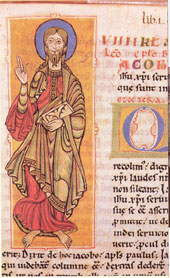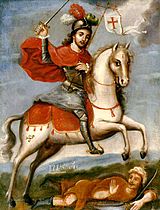James and Spain
According to ancient local tradition, on 2 January of the year AD 40, the Virgin Mary appeared to James on the bank of the Ebro River at Caesaraugusta, while he was preaching the Gospel in Iberia. She appeared upon a pillar, Nuestra Señora del Pilar, and that pillar is conserved and venerated within the present Basilica of Our Lady of the Pillar, in Zaragoza, Spain. Following that apparition, St James returned to Judea, where he was beheaded by King Herod Agrippa I in the year 44. [4] [5]
The 12th-century Historia Compostellana commissioned by bishop Diego Gelmírez provides a summary of the legend of St James as it was believed at Compostela. Two propositions are central to it: first, that St James preached the gospel in Iberia as well as in the Holy Land; second, that after his martyrdom at the hands of Herod Agrippa I his disciples carried his body by sea to Iberia, where they landed at Padrón on the coast of Galicia, and took it inland for burial at Santiago de Compostela.
The translation of his relics from Judea to Galicia in the northwest of Iberia was effected, in legend, by a series of miraculous happenings: decapitated in Jerusalem with a sword by Herod Agrippa himself, his body was taken up by angels, and sailed in a rudderless, unattended boat to Iria Flavia in Iberia, where a massive rock closed around his relics, which were later removed to Compostela. An even later tradition states that he miraculously appeared to fight for the Christian army during the battle of Clavijo, and was henceforth called Matamoros (Moor-slayer). Santiago y cierra España ("St James and strike for Spain") has been the traditional battle cry of Spanish armies.
| “ | St James the Moorslayer, one of the most valiant saints and knights the world ever had ... has been given by God to Spain for its patron and protection. | ” |
A similar miracle is related about San Millán. The possibility that a cult of James was instituted to supplant the Galician cult of Priscillian (executed in 385) who was widely venerated across the north of Iberia as a martyr to the bishops rather than as a heretic should not be overlooked. This was cautiously raised by Henry Chadwick in his book on Priscillian[4] ; it is not the traditional Roman Catholic view. The Catholic Encyclopedia of 1908, however, states:
Although the tradition that James founded an apostolic see in Iberia was current in the year 700, no certain mention of such tradition is to be found in the genuine writings of early writers nor in the early councils; the first certain mention we find in the ninth century, in Notker, a monk of St. Gall (Martyrologia, 25 July), Walafrid Strabo (Poema de XII Apostoli), and others.

The tradition was not unanimously admitted afterwards, while numerous modern scholars, following Louis Duchesne, reject it. The Bollandists however defended it (their Acta Sanctorum, July, VI and VII, gives further sources). The suggestion began to be made from the 9th century that, as well as evangelizing in Iberia, his body may have been brought to Compostela. No earlier tradition places the burial of St James in Hispania. A rival tradition, places the relics of the Apostle in the church of St. Saturnin at Toulouse, but it is not improbable that such sacred relics should have been divided between two churches.
The authenticity of the relics at Compostela was asserted in the Bull of Pope Leo XIII, Omnipotens Deus, of 1 November 1884.
The Catholic Encyclopedia (1908) registered several "difficulties" or bases for doubts of this tradition beyond the late appearance of the legend:
James suffered martyrdom[Acts 12:1-2] in AD 44. According to the tradition of the early Church, he had not yet left Jerusalem at this time.[6] St Paul in his Epistle to the Romans written after AD 44, expressed his intention to avoid "building on someone else's foundation",[Rom. 15:20]and thus visit Spain[15:24] which was presumably unevangelized.
The tradition at Compostela placed the discovery of the relics of the saint in the time of king Alfonso II (791-842) and of bishop Theodemir of Iria. These traditions were the basis for the pilgrimage route that began to be established in the 9th century, and the shrine dedicated to James at Santiago de Compostela, in Galicia in Spain, became the most famous pilgrimage site in the Christian world.[citation needed] The Way of St. James is a tree of routes that cross Western Europe and arrive at Santiago through Northern Spain. Eventually James became the patron saint of Spain.

The English name "James" comes from Italian "Giacomo", a variant of "Giacobo" derived from Iacobus (Jacob) in Latin, itself from the Greek Iacovos. In French, Jacob is translated "Jacques". In eastern Spain, Jacobus became "Jacome" or "Jaime"; in Catalunya, it became Jaume, in western Iberia it became "Iago", from Hebrew Ya'akov, which when prefixed with "Sant" became "Santiago" in Portugal and Galicia; "Tiago" is also spelled "Diego", which is also the Spanish name of Saint Didacus of Alcalá.
James' emblem was the scallop shell (or "cockle shell"), and pilgrims to his shrine often wore that symbol on their hats or clothes. The French for a scallop is coquille St. Jacques, which means "cockle (or mollusk) of St James". The German word for a scallop is Jakobsmuschel, which means "mussel (or clam) of St. James"; the Dutch word is Jacobsschelp, meaning "shell of St James".




No hay comentarios:
Publicar un comentario